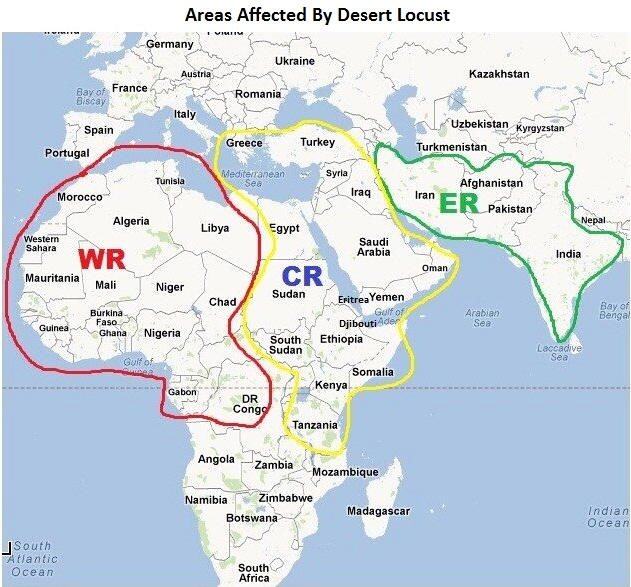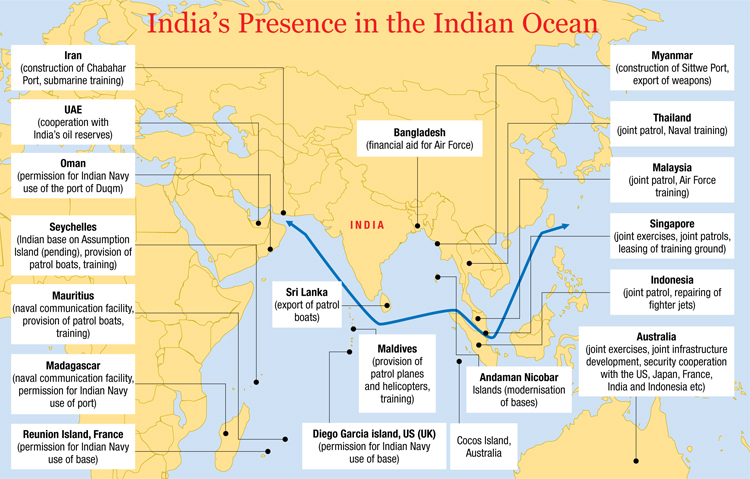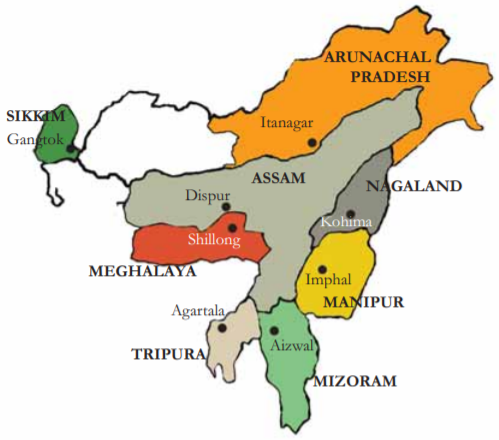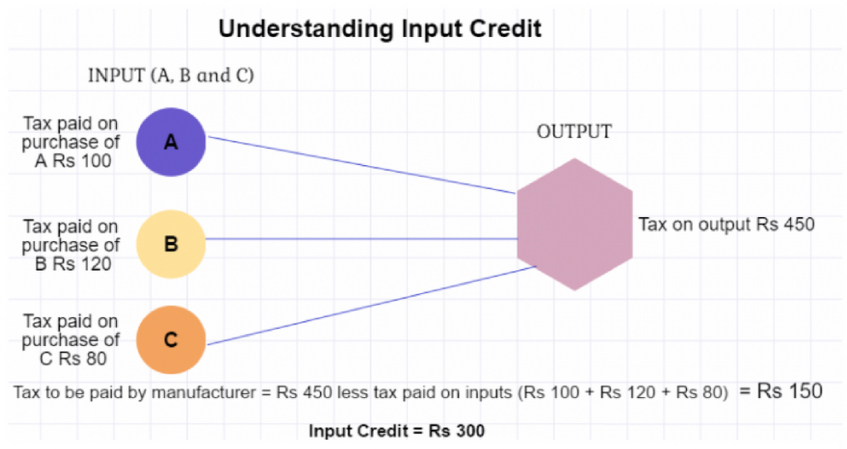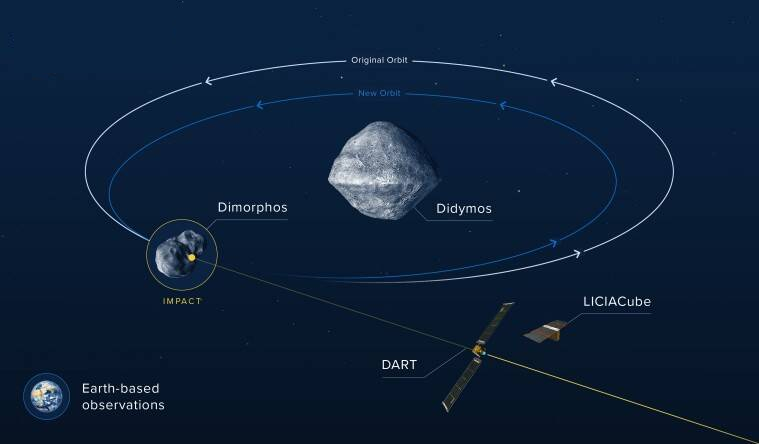Biodiversity & Environment
Climate Change & Locust Infestations
Why in News
Infestation of desert locusts, which has plagued a vast swathe from eastern Africa to India in recent years, has been closely linked to climate change.
- In this context, the Global Landscapes Forum Climate Hybrid Conference has proposed that plans to mitigate climate change must include action against pests and diseases.
- The conference was recently held alongside the 26th Conference of Parties (CoP26) to the United Nations Framework Convention on Climate Change.
Global Landscapes Forum
- The Global Landscapes Forum (GLF) is the world’s largest knowledge-led platform on integrated land use, dedicated to achieving the Sustainable Development Goals and Paris Climate Agreement.
- It is led by the Center for International Forestry Research (CIFOR), in collaboration with its co-founders UNEP and the World Bank and Charter Members.
Key Points
- Locust Attack and its Impact:
- About: The desert locust (Schistocerca gregaria) is a short-horned grasshopper.
- Harmless when solitary, locusts undergo a behavioural change when their population builds up rapidly.
- They enter the ‘gregarious phase’ by forming huge swarms that can travel up to 150 km per day, eating up every bit of greenery on their way.
- Impact: Locust infestations can harm livelihoods and be a threat to regional investments in ensuring food security.
- According to the World Bank: In East Africa and Yemen alone, damages and losses in 2020 due to locusts could amount to as much as $8.5 billion.
- According to the World Food Program: The long-term response and recovery costs could top $1billion if swarm growth is not controlled.
- About: The desert locust (Schistocerca gregaria) is a short-horned grasshopper.
- Locust Breeding and Linkage With Climate Change:
- Affected Area: Locusts have been a bane especially to farmers in several countries, including India, Pakistan and Iran.
- Effect of Climate Change: Change in cyclonic patterns over the Arabian Sea is behind the locust invasions in east Africa, west and south Asia, in 2020.
- Unusual rainfall in Iran helped in their breeding.
- Locusts are known to be passive flyers and generally follow the wind.
- Their movement has been aided by westerly winds, which were further strengthened by the low-pressure area created by Cyclone Amphan (2019) in the Bay of Bengal.
- Pesticide is Not the Appropriate Solution:
- It said that heavy use of a broad-spectrum pesticide may slow down the desert locust invasion but they also exert significant external costs on the environment and human health.
- They are a threat to pollinators and wildlife.
- A broad-spectrum pesticide is a powerful pesticide that targets entire groups or species of organisms that are commonly harmful to plants.
- According to the Food and Agriculture Organization (FAO), by March 2021, 1.8 million litres of pesticides were used to control locusts in East Africa. This may increase to over two million litres by the end of 2021.
- Organophosphate pesticides such as Malathion and Chlorpyrifos, for instance, are highly toxic to humans and animals.
- It said that heavy use of a broad-spectrum pesticide may slow down the desert locust invasion but they also exert significant external costs on the environment and human health.
Way Forward
- Early Warning System: Satellite and weather data, along with field observations, can be used for building powerful predictive models on breeding sites.
- True Cost Accounting: Counting the environmental and human costs through True Cost Accounting.
- True Cost Accounting is a new type of bookkeeping that does not just look at the usual financial values within a company, but also calculates the impacts on natural and social capital.
- Developing an Efficient Governance Model: Governing the locusts crisis may also provide useful lessons for the agri-food system.
- There is a need to raise awareness amongst farmers and local communities as well as involve them in decision making.
- Mobilising Funds for Research: It is important to fund research on the biopesticide sector which remains extremely underfunded.
- The organisations responsible for preventing locust attacks face tremendous financial hurdles.
- In February 2020, $138 million was required by FAO to combat locusts outbreaks in East Africa. The organisation received only $33 million from donors.


International Relations
China Delivers Largest Warship to Pakistan: PNS Tughril
Why in News
Recently, China handed over the first Type 054A/P frigate (warship) to Pakistan. It is named the PNS Tughril.
- The PNS Tughril is the first hull of four Type 054 frigates being constructed for the Pakistan Navy.
Key Points
- Features:
- The ship is a technologically advanced and highly capable platform with enormous surface-to-surface, surface-to-air and underwater firepower, besides extensive surveillance potentials.
- This warship has world-class stealth capability and can easily dodge any radar.
- It also has long-range missiles and a state-of-the-art cannon capable of firing multiple rounds in a minute.
- The warship is fitted with a state-of-the-art Battle Management System (BMS), which will increase the fighting capability of the Pakistan Navy manifold.
- BMS basically helps communicate between the radar and the interceptor missile.
- Concerns for India:
- It will strengthen Pakistan Navy's capabilities to respond to maritime challenges to ensure seaward defence in the Indian Ocean region.
- It will form the mainstay of the Pakistan Navy fleet while bolstering the Pakistan Navy's maritime defence capabilities.
- Besides the advanced naval ships, China also partners with the Pakistan Air Force to build JF-17 Thunder fighter aircraft.
- Besides building its first military base in Djibouti in the Horn of Africa in the Indian Ocean, China has acquired Pakistan's Gwadar port in the Arabian Sea which connects with China's Xinjiang province by land in the USD 60 billion China Pakistan Economic Corridor (CPEC).
- China is also developing Sri Lanka's Hambantota port after it acquired it on 99 years' lease.
- The modernisation of the Pakistan Navy coupled with the acquisition of the naval bases was expected to shore up the Chinese Navy's presence in the Indian Ocean and the Arabian Sea.
- It will strengthen Pakistan Navy's capabilities to respond to maritime challenges to ensure seaward defence in the Indian Ocean region.
India’s Rising Profile in the Indian Ocean Region
- Various Agreements with Littoral Nations: India has negotiated agreements with several states in the littoral IOR to obtain military access to their bases.
- Such agreements, including access to Indonesia’s strategically-located deep-sea Sabang port and Oman’s Duqm port, enhance New Delhi’s geopolitical positioning as it looks to counter China’s “string of pearls.”
- Engagement Outside IOR: India has engaged with powers outside of the IOR, deepening cooperation with France and the United States through logistics agreements,
- This grants India access to port facilities at the US base on Diego Garcia (southernmost member of the Chagos Archipelago, in the central Indian Ocean) and the French base on Reunion Island.
- Quadrilateral Dialogue: The United States engages with India through the informal Quadrilateral Security Dialogue, or the “Quad,” which also includes Australia and Japan.
- Paris-New Delhi-Canberra Axis: France has called for the creation of a “Paris-New Delhi-Canberra” axis in the Indo-Pacific, underscoring India’s growing influence on geopolitics in the IOR.
- Information Fusion Centre for the Indian Ocean Region (IFC-IOR): IFC-IOR is established with the vision of strengthening maritime security in the region, by building a common coherent maritime situation picture and acting as a maritime information hub for the region.
- Maritime Exercises: India concluded an edition of its “Malabar” naval exercise, which included the US, Japan and Australia.
- In 2018, India also held multilateral naval exercises called “Milan” in the Andaman and Nicobar Islands with 16 other countries and in the Rim of the Pacific Exercise (RIMPAC), sailing alongside the Australian, Japanese, and US naval forces.
- Naval Ships: While India already has one commissioned carrier, the INS Vikramaditya, and plans to commission a second, the INS Vikrant, it has outlined an ambitious plan to develop a class of aircraft carriers to follow the Vikrant.
- India’s navy has further outlined plans to procure 57 carrier-based fighter jets, as well as modernize its submarine fleet with a new Arihant -class of nuclear-powered attack vessels.
Governance
Destination Northeast India
Why in News
Recently, a seven-day cultural festival of the northeast as part of the celebrations of 75 years of Independence under the Azadi Ka Amrut Mahotsav programme cocncluded at the National Museum, Delhi.
- It is celebrating the rich heritage of North East India, under the Ministry of Development of North Eastern Region & North Eastern Council (NEC)’s initiative titled “Destination NorthEast India”.
Key Points
- Aim: To bring the rest of India closer to North East (NE) India.
- It holds a special presentation of art and craft, textiles, ethnic products, tourism promotion etc. of the eight northeastern states.
- Organisations Involved:
- Ministry of Development of North-East Region.
- North Eastern Council (NEC): It is the nodal agency for the economic and social development of the NE Region which consists of the eight States of Arunachal Pradesh, Assam, Manipur, Meghalaya, Mizoram, Nagaland, Sikkim and Tripura. It was constituted in 1971 by an Act of Parliament.
- National Museum: The blueprint for establishing the National Museum in Delhi was prepared by the Maurice Gwyer Committee in May 1946.
- It was initially looked after by the Director General of Archaeology until 1957, when the Ministry of Education declared it a separate institution and placed it under its own direct control.
- At present, the National Museum is under the administrative control of the Ministry of Culture.
Importance of NE Region
- Strategic Location: The NER is strategically located with access to the traditional domestic market of eastern India, along with proximity to the major states in the east and adjacent countries such as Bangladesh and Myanmar.
- Links with Southeast Asia: With ASEAN engagement becoming a central pillar of India’s foreign policy direction, NE states play an important role as the physical bridge between India and Southeast Asia.
- The India's Act East Policy places the northeastern states on the territorial frontier of India's eastward engagement.
- Economic Significance: The NER has immense natural resources, accounting for around 34% of the country’s water resources and almost 40% of India’s hydropower potential.
- Sikkim is India’s first organic state.
- Tourism Potential: Northeast of India is home to many wildlife sanctuaries like Kaziranga National Park famous for the one horned rhinoceros, Manas National Park, Nameri, Orang, Dibru Saikhowa in Assam, Namdapha in Arunachal Pradesh, Balpakram in Meghalaya, Keibul Lamjao in Manipur, Intanki in Nagaland, Khangchendzonga in Sikkim.
- Cultural Significance: Tribes in NER have their own culture. Popular festivals include Hornbill Festival of Nagaland, Pang Lhabsol of Sikkim, etc.
Government Initiatives for NE Region
- Ministry of Development of North Eastern Region (DoNER): A Department of Development of North Eastern Region (DoNER) was established in 2001. It was elevated to a full ministry in 2004.
- Infrastructure Related Initiatives:
- Under Bharatmala Pariyojana (BMP), road stretches aggregating to about 5,301 km in NER have been approved for improvement.
- The North East has been kept as a priority area under RCS-UDAN (to make flying more affordable).
- Connectivity Projects: Kaladan Multi-Modal Transit Project (Myanmar) and Bangladesh-China-India-Myanmar (BCIM) Corridor.
- For Promoting Tourism: Under the Swadesh Darshan Scheme of the Ministry of Tourism, projects worth Rs.1400.03 crore have been sanctioned for the NER in the last five years.
- Mission Purvodaya: Purvodaya in the steel sector is aimed at driving accelerated development of Eastern India through the establishment of an integrated steel hub.
- The Integrated Steel Hub, encompassing Odisha, Jharkhand, Chhattisgarh, West Bengal and Northern Andhra Pradesh, would serve as a torchbearer for socio-economic growth of Eastern India.
- North-East Industrial Development Scheme (NEIDS): In order to promote employment in the North East States, the Government is incentivizing primarily the MSME Sector through this scheme.
- The National Bamboo Mission has a special significance for the Northeast.
- North Eastern Region Vision 2020: The document provides an overarching framework for the development of the NE Region to bring it at par with other developed regions under which different Ministries, including the Ministry of DoNER have undertaken various initiatives.
- Digital North East Vision 2022: It emphasises leveraging digital technologies to transform lives of people of the north east and enhance the ease of living.


Indian Polity
Privilege Motion
Why in News
Congress’ chief whip in the Rajya Sabha sought to move a privilege motion against the Union Culture Minister over the appointment of chairperson of the National Monuments Authority (NMA).
- The educational and professional background of the current chairperson of NMA does not meet the requirements of law passed by Parliament in March 2010.
National Monuments Authority (NMA)
- Established: NMA is set up under the Ministry of Culture as per the provisions of the Ancient Monuments and Archaeological Sites and Remains (Amendment and Validation) Act (AMASR) which was enacted in March, 2010.
- Functions: Several functions have been assigned to the NMA for the protection and preservation of monuments and sites through management of the prohibited and regulated areas around the centrally protected monuments.
- NMA also considers grant of permissions to applicants for construction related activity in the prohibited and regulated areas.
- Qualifications for the Appointment of the Chairman: AMASR Act says that the chairperson of the NMA should have “proven experience and expertise in the field of archaeology, country and town planning, architecture, heritage, conservation architecture or law”.
Key Points
- About: It is concerned with the breach of parliamentary privileges by a minister.
- Breach of Parliamentary Privileges: Parliamentary Privileges are certain rights and immunities enjoyed by members of Parliament, individually and collectively, so that they can “effectively discharge their functions”.
- When any of these rights and immunities are disregarded, the offence is called a breach of privilege and is punishable under law of Parliament.
- A notice is moved in the form of a motion by any member of either House against those being held guilty of breach of privilege.
- Its purpose is to censure the concerned minister.
- Role of the Speaker/Rajya Sabha (RS) Chairperson:
- The Speaker/RS chairperson is the first level of scrutiny of a privilege motion.
- The Speaker/Chairperson can decide on the privilege motion himself or herself or refer it to the privileges committee of the Parliament.
- If the Speaker/Chairperson gives consent under relevant rules, the member concerned is given an opportunity to make a short statement.
- Rules Governing Privilege:
- Rule No 222 in Chapter 20 of the Lok Sabha Rule Book and correspondingly Rule 187 in Chapter 16 of the Rajya Sabha rulebook governs privilege.
- Rules say that a member may, with the consent of the Speaker or the Chairperson, raise a question involving a breach of privilege either of a member or of the House or a committee thereof.
Parliamentary Privileges
- Parliamentary privileges are special rights, immunities and exemptions enjoyed by the two Houses of Parliament, their committees and their members.
- The Constitution also extends the parliamentary privileges to those persons who are entitled to speak and take part in the proceedings of a House of Parliament or any of its committees. These include the Attorney General of India and Union ministers.
- The parliamentary privileges do not extend to the President who is also an integral part of the Parliament. Article 361 of the Constitution provides for privileges for the President.
- Article 105 of the Constitution expressly mentions two privileges, that is, freedom of speech in Parliament and right of publication of its proceedings.
- Apart from the privileges as specified in the Constitution, the Code of Civil Procedure, 1908, provides for freedom from arrest and detention of members under civil process during the continuance of the meeting of the House or of a committee thereof and forty days before its commencement and forty days after its conclusion.
- It needs to be noted that the Parliament, till now, has not made any special law to exhaustively codify all the privileges.
Privilege Committee
- It is a Standing Committee. It examines the cases of breach of the privileges of the House and its members and recommends appropriate action.
- The Lok Sabha committee has 15 members, while the Rajya Sabha committee has 10 members.
Indian Economy
CBIC Guidelines on Blocking Input Tax Credit
Why in News
Recently, the CBIC (Central Board of Indirect Taxes and Customs) issued guidelines on blocking of tax credit by GST (Goods and Services Tax) field officers, saying that such blocking should be on the basis of 'material evidence' and not just out of 'suspicion'.
Key Points
- Input Tax Credit:
- It is the tax that a business pays on a purchase and that it can use to reduce its tax liability when it makes a sale.
- It means at the time of paying tax on output, one can reduce the tax that has already been paid on inputs and pay the balance amount.
- Exceptions: A business under composition scheme cannot avail of input tax credit. ITC cannot be claimed for personal use or for goods that are exempt.
- Composition Scheme is a scheme under GST which can be opted to get rid of tedious GST formalities.It can be opted by any taxpayer whose turnover is less than Rs. 1.5 crore.
- Provisions for Claiming ITC:
- The amended Rule 36 (4) of the CGST (Central GST) Rules, 2017, provides that the input tax credit can be availed only when a supplier of goods updates and uploads online the details of supplies through each of the bills.
- New Guidelines:
- It laid down some specific circumstances in which such ITC could be blocked by a senior tax officer.
- These include availment of credit without any invoice or any valid document, or availing of credit by purchasers on invoices on which GST has not been paid by sellers.
- The commissioner, or an officer authorised by him, not below the rank of assistant commissioner, must form an opinion for blocking of ITC only after "proper application of mind" considering all the facts of the case.
- The government had introduced Rule 86A in GST rules in December 2019 giving powers to taxmen to block the ITC available in the electronic credit ledger of a taxpayer if the officer has "reasons to believe" that the ITC was availed fraudulently.
- The reasons are to be on the basis of material evidence available or gathered in relation to fraudulent availment of input tax credit or ineligible input tax credit availed as per the conditions/grounds under sub-rule (1) of Rule 86A.
- These guidelines have recommended monetary limits for the division of powers between commissions, joint commissioners, and assistant commissioners on blocking of the tax credit.
- A deputy or assistant commissioner can block ITC up to Rs 1 crore, additional or joint commission above Rs 1 crore but not exceeding Rs 5 crore and principal commissioner or commissioner above Rs 5 crore.
- In case an officer blocks the ITC under due procedure, the taxpayer will be informed about the action on the GST portal along with details of the officer who has blocked it.
Central Board of Indirect Taxes and Customs
- It is a part of the Department of Revenue under the Ministry of Finance.
- The Central Board of Excise and Customs (CBEC) was renamed as the CBIC in 2018 after the roll out of the GST.
- It deals with the tasks of formulation of policy concerning levy and collection of customs, central excise duties, Central GST (CGST) and Integrated GST (IGST).
- GST Law comprising (i) Central Goods and Services Tax Act, 2017 (ii) State Goods and Services Tax Act, 2017 (iii) Union Territory Goods and Services Tax Act, 2017, (iv) Integrated Goods and Services Tax Act, 2017 (v) Goods and Services Tax (Compensation to States) Act, 2017.


Science & Technology
Double Asteroid Redirection Test (DART) Mission: NASA
Why in News
NASA will launch its first planetary defense test mission named the Double Asteroid Redirection Test (DART).
- The DART spacecraft will be launched on a SpaceX Falcon 9 rocket.
Key Points
- Aim of the Mission:
- The mission is to test the new technology to be prepared in case an asteroid heads towards Earth in the future.
- The aim is to test the newly developed technology that would allow a spacecraft to crash into an asteroid and change its course.
- After the mission has collided with the asteroid, scientists will study its impact on the trajectory of the asteroid with a range of telescopes deployed on different regions of the planet.
- DART will be the first demonstration of the kinetic impactor technique to change the motion of an asteroid in space.
- The target of the spacecraft is a small moonlet called Dimorphos (Greek for “two forms”).
- Dimorphos orbits a larger asteroid named Didymos (Greek for “twin”).
- It is a suicide mission and the spacecraft will be completely destroyed.
- The collision is expected to take place between 26th September and 1st October, 2022.
- About the Mission:
- DART is a low-cost spacecraft.
- It has two solar arrays and uses hydrazine propellant for maneuvering the spacecraft.
- It also carries about 10 kg of xenon which will be used to demonstrate the agency’s new thrusters called NASA Evolutionary Xenon Thruster–Commercial (NEXT-C) in space.
- NEXT-C gridded ion thruster system provides a combination of performance and spacecraft integration capabilities that make it uniquely suited for deep space robotic missions.
- The spacecraft carries a high-resolution imager called Didymos Reconnaissance and Asteroid Camera for Optical Navigation (DRACO).
- Images from DRACO will be sent to Earth in real-time and will help study the impact site and surface of Dimorphos (the target asteroid).
- DART will also carry a small satellite or CubeSat named LICIACube (Light Italian CubeSat for Imaging of Asteroids).
- LICIACube is expected to capture images of the impact and the impact crater formed as a result of the collision.
- Reason for Choosing Dimorphos:
- Didymos is a perfect system for the test mission because it is an eclipsing binary which means it has a moonlet that regularly orbits the asteroid and which can be seen when it passes in front of the main asteroid.
- Earth-based telescopes can study this variation in brightness to understand how long it takes Dimorphos to orbit Didymos.
Indian History
Abul Kalam Azad: National Education Day
Why in News
Every year, 11th November is celebrated as National education day, which commemorates the birth anniversary of independent India’s first education minister, Maulana Abul Kalam Azad.
- In 2008, the Ministry of Human Resource Development (Now Ministry of Education) decided to celebrate Azad’s birthday as National Education Day. Educational institutions across India mark the event with seminars, essay-writing, workshops etc to highlight the importance of education.
Key Points
- Birth: Maulana Abul Kalam Azad, originally named Muhiyuddin Ahmad, was born on 11th November 1888 in Mecca, Saudi-Arabia.
- Azad was a brilliant debater, as indicated by his name - “Abul Kalam” which literally means “Lord of Dialogues”.
- Brief Profile:
- He donned many hats of being a journalist, freedom fighter, politician, and educationist.
- Contributions (Pre-Independence):
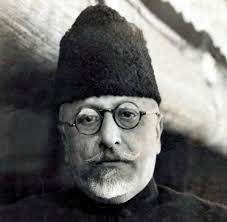
- He was a proponent of Hindu Muslim unity, opposed to Partition.
- In 1912, he started a weekly journal in Urdu called Al-Hilal which played an important role in forging Hindu-Muslim unity after the bad blood created between the two communities in the aftermath of Morley-Minto reforms (1909).
- Under the 1909 reforms, the provision of separate electorates for Muslims was resented by Hindu.
- The government regarded Al- Hilal as a propagator of secessionist views and banned it in 1914.
- Maulana Abul Kalam Azad then started another weekly called Al-Balagh with the same mission of propagating Indian nationalism and revolutionary ideas based on Hindu-Muslim unity.
- In 1916, the government banned this paper too and expelled Maulana Abul Kalam Azad from Calcutta and exiled him to Bihar from where he was released after the First World War 1920.
- In 1912, he started a weekly journal in Urdu called Al-Hilal which played an important role in forging Hindu-Muslim unity after the bad blood created between the two communities in the aftermath of Morley-Minto reforms (1909).
- Azad supported the Non-Cooperation Movement (1920-22) started by Gandhiji and entered the Indian National Congress in 1920.
- In 1923, he was elected as the president of Indian National Congress. At an age of 35, he became the youngest person to serve as the President of the Indian National Congress.
- Maulana Azad was arrested in 1930 for violation of the salt laws as part of Gandhiji’s Salt Satyagraha. He was put in Meerut jail for a year and a half.
- He again became the president of Congress in 1940 and remained in the post till 1946.
- He was a proponent of Hindu Muslim unity, opposed to Partition.
- An Educationist:
- In the field of education, Maulana Azad had been an uncompromising exponent of universalism, a truly liberal and humanitarian educational system.
- Azad’s ideal was a fusion of the Eastern and Western concepts of man, to create a fully integrated personality. Whereas the Eastern concept dwelt on spiritual excellence and individual salvation, the Western concept laid stress on worldly achievements and social progress.
- He was one of the founding members of the Jamia Milia Islamia University, originally established at Aligarh in the United Provinces in 1920.
- His Works: Basic Concept of Quran, Ghubar-eKhatir, Dars-e-Wafa, India Wins Freedom, etc.
- Contributions (Post-Independence):
- In 1947, he became the first education minister of free India and remained at this post till his death in 1958. In his tenure, he did tremendous work for the upliftment of the country.
- The first IIT, IISc, School of Planning and Architecture and the University Grants Commission were established under his tenure as the education minister.
- Indian Council for Cultural Relations, for introduction of Indian culture to other nations.
- Following three academics were formed:
- Sahitya Academy for development of literature;
- Sangeet Natak Academy for the development of Indian music and dance;
- Lalit Kala Academy for the development of painting.
- Maulana Abul Kalam Azad was posthumously awarded India's highest civilian honour, Bharat Ratna in 1992.
- In 1947, he became the first education minister of free India and remained at this post till his death in 1958. In his tenure, he did tremendous work for the upliftment of the country.


Important Facts For Prelims
Acharya Kriplani
Why in News
Recently, The Prime Minister has paid tributes to Acharya Kripalani on his Birth Anniversary (11th November).
Key Points
- About:
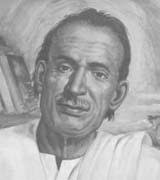
- He was born on 11th November 1888 in Hyderabad, Sindh.
- His original name was Jivatram Bhagwandas Kripalani but was popularly known as Acharya Kripalani. He was an independence activist, Indian politician and an Educationist.
- Educationist:
- From 1912 to 1927, he taught at various places before becoming wholly involved in the freedom movement.
- He earned the moniker ‘Acharya’ around 1922 when he was teaching at the Gujarat Vidyapith, founded by the Mahatma a couple of years before.
- An Environmentalist:
- He, along with Vinoba Bhave, was involved in preservation and conservation activities throughout the 1970s.
- Independence Activist:
- He was part of the Non-Cooperation Movement (1920-22) and the Civil Disobedience movements (started in 1930) and Quit India Movement (1942).
- He was the President of Indian National Congress (INC) at the time of independence. He served in the Interim government of India (1946–1947) and the Constituent Assembly of India.
- Political Career:
- He became one of the founders of the Kisan Mazdoor Praja Party (KMPP) after independence leaving congress.
- He was elected to the Lok Sabha in 1952, 1957, 1963 and 1967 as a member of Praja Socialist Party.
- He moved the first-ever No confidence motion in Lok Sabha in 1963, immediately after the India-China War (1962).
- In 1963, Sucheta Kripalani, a Congress leader became the Chief Minister of Uttar Pradesh, a first for any woman in the country while her husband Acharya remained an opponent to the Congress.
- He was a critic of Nehru's policies and Indira Gandhi’s rule. He was arrested during Emergency (1975).
- My Times, his autobiography published posthumously in 2004.
Important Facts For Prelims
US Joins International Solar Alliance
Why in News
Recently, the United States of America has become the 101st member country to join the International Solar Alliance (ISA).
- Earlier, the fourth general assembly of ISA was held.
Key Points
- About:
- The ISA is an intergovernmental treaty-based organisation with a global mandate to catalyse solar growth by helping to reduce the cost of financing and technology.
- ISA is the nodal agency for implementing One Sun One World One Grid (OSOWOG), which seeks to transfer solar power generated in one region to feed the electricity demands of others.
- Launch:
- It is an Indian initiative that was launched by the Prime Minister of India and the President of France on 30th November 2015 in Paris, France on the side-lines of the UNFCCC Conference of the Parties (COP-21), with 121 solar resource rich countries lying fully or partially between the tropic of Cancer and tropic of Capricorn as prospective members.
- Members:
- 101 members, after being joined by the US.
- Headquarters:
- The Headquarters is in India with its Interim Secretariat being set up in Gurugram.
- Objectives:
- To collectively address key common challenges to the scaling up of solar energy in ISA member countries.
- New ISA Programmes:
- New ISA programmes have been launched on management of solar PV panels & battery usage waste and solar hydrogen programme.
- The new Hydrogen initiative is aimed at enabling the use of solar electricity to produce hydrogen at a more affordable rate than what is available currently (USD 5 per KG), by bringing it down to USD 2 per KG.
- New ISA programmes have been launched on management of solar PV panels & battery usage waste and solar hydrogen programme.



